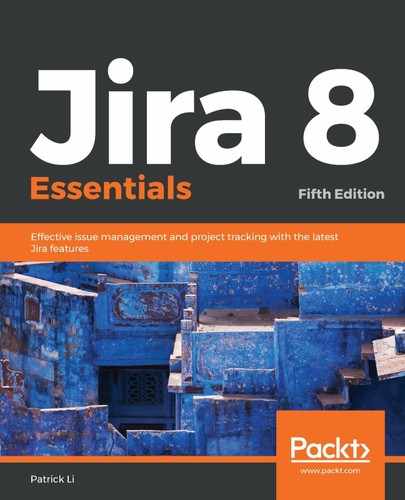Chapter 1, Getting Started with Jira, serves as an overall introduction to Jira by going over its high-level architecture. We will cover both fresh new deployments and how to upgrade from an existing deployment. This will also serve as the starting point of the project that readers will go through.
Chapter 2, Using Jira for Business Projects, covers using Jira for projects that are not based on software development, for example, a generic task management solution. This chapter focuses on use the basic features of Jira, which are offered through the Jira Core product, which is bundled with Jira Software.
Chapter 3, Using Jira for Agile Projects, covers features that are specific to Jira Software. This chapter focuses on using JIRA for software development projects, especially using Agile methodologies such as Scrum and Kanban.
Chapter 4, Issue Management, introduces issues, which are the cornerstone of using Jira. The focus is to make sure users understand issues and what they do. You will also learn how to make each of the features available and customize them further beyond the out-of-box settings.
Chapter 5, Field Management, introduces fields, and specifically how to use custom fields to customize Jira for more effective data collection. You will learn how to create different types of custom fields and their usages, and how to control field behaviors such as visibility and rendering options.
Chapter 6, Screen Management, introduces screens. You will learn how to create new screens from scratch and specify which fields (system and custom) will be displayed. We will also cover the complex scheme mappings to apply new screens to projects.
Chapter 7, Workflow and Business Process, explores the most powerful feature offered by Jira, workflows. The concept of issue life cycles is introduced, and various aspects of workflows are explained. This chapter also explores the relationship between workflows and other various Jira aspects that have been previously covered, such as screens. The concept of Jira add-ons is also briefly touched upon in the sample project, using some popular add-ons.
Chapter 8, Emails and Notifications, talks about emails and how Jira can use it to send notifications with end users. We will start by explaining how Jira sends out notifications to users, and then how Jira can process incoming emails to create, comment, and also update issues.
Chapter 9, Securing Jira, explains Jira's security model, starting with how to manage users, groups, and roles. Readers will then learn Jira's security hierarchy of how permissions are managed. Lastly, we will look at integrating JIRA with LDAP, a common requirement with most enterprise organizations.
Chapter 10, Searching, Reporting, and Analysis, focuses on doing more with data collected by Jira, including searching, reporting, and using dashboards. Readers will also learn how to make this data and reports available outside of Jira, either via email, or by displaying them in other applications.
Chapter 11, Jira Service Desk, introduces one of the new add-ons, called Jira Service Desk, which allows you to run Jira as a customer support portal. Readers will learn how to use Jira Service Desk to run and manage a support queue internally while at the same time communicating effectively with customers with the add-on.
